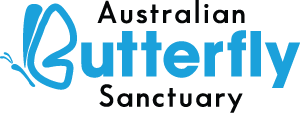Kuranda Attraction
Butterflies & Moths
The Australian Butterfly Sanctuary is the leading Kuranda attraction.
It is the largest butterfly flight aviary and exhibit in Australia – an all-weather experience in the heart of the beautiful Kuranda village.
Home to over 1200 magnificent tropical butterflies, you’ll be enchanted by the aerial dynamics of these elusive wonders of nature as you wander through the aviary’s rainforest gardens. Our butterflies include local rainforest species, including the majestic green & yellow Cairns Birdwing.
a beautiful journey
Lifecycle of Butterfly
The lifecycle of a butterfly consists of four distinct stages:
- Egg
- Caterpillar
- Pupa (chrysalis)
- Adult
Egg Stage – Typically lasts for a few days to a couple of weeks, depending on the species.
Caterpillar stage - The primary goal of a caterpillar is to eat and grow. The Caterpillar needs to shed its skin to grow. It does this several times during the caterpillar stage, each growth spurt is called an instar.
Pupa (chrysalis) stage – During this phase, the caterpillar undergoes a remarkable transformation. This process is called metamorphosis, and it involves the breakdown of caterpillar tissues and the formation of adult butterfly structures.
Adult stage (butterfly) - Once the metamorphosis is complete, an adult butterfly emerges from the chrysalis. The adult butterfly's primary focus is reproduction, and the cycle repeats as the female lay’s eggs on suitable host plants.
This intricate process of metamorphosis ensures the survival and adaptation of butterfly species in diverse ecosystems.
Know your butterfly
Who is who
Far North Queensland is home to a rich and diverse array of butterflies that come in a wide variety of sizes and colors and have distinctive markings on their wings, such as spots, stripes, or eyespots.
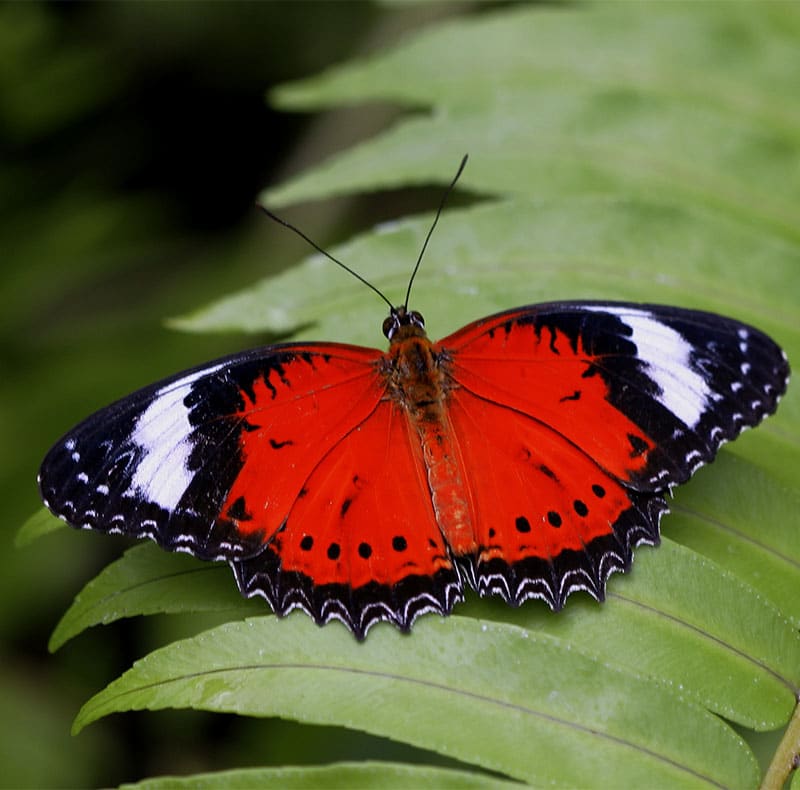
Cethosia chrysippe
Red Lacewing butterflies are found in North Queensland, Papua New Guinea and Indonesia.
Did you know?
– They are Australia’s only bright red butterfly and one of the few predominantly red butterflies in the world.
– The food plant for the caterpillar is Adenia heterophylla.
– The caterpillars are yellow and black striped and feed in groups.
– Both the caterpillar and the butterfly display warning colours to deter predators.
– This butterfly only lives 7 to 10 days.
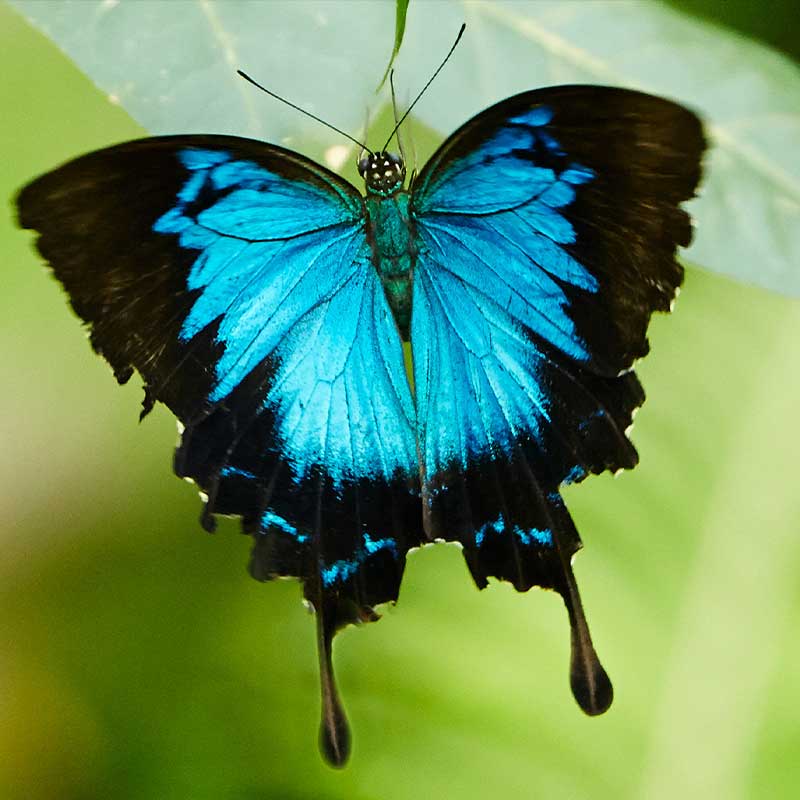
Papilio ulysses
The Ulysses butterfly is found in most tropical rainforest areas such as Northern Queensland, Northern islands of Australia and Papua New Guinea and lives below the rainforest canopy.
Did you know?
– Its common name is “Mountain Blue Butterfly” and is a large swallowtail butterfly.
– The Ulysses wing span is between 100 and 130 mm.
– The Ulysses caterpillar is green and white which is the same colour as the plants they feed on. This provides excellent camouflage from predators.

Ornithoptera euphorion
The Cairns Birdwing butterfly is the largest of all Australian butterflies and found along northeastern Australia from Mackay to Cooktown.
Did you know?
– This butterfly is easily identified due to its vivid colouration.
– The female’s wingspan can measure 18cm.
– As soon as adult butterflies hatch they mate quickly because they only live for 4 to 5 weeks.
– Their favourite habitat is the rainforest.
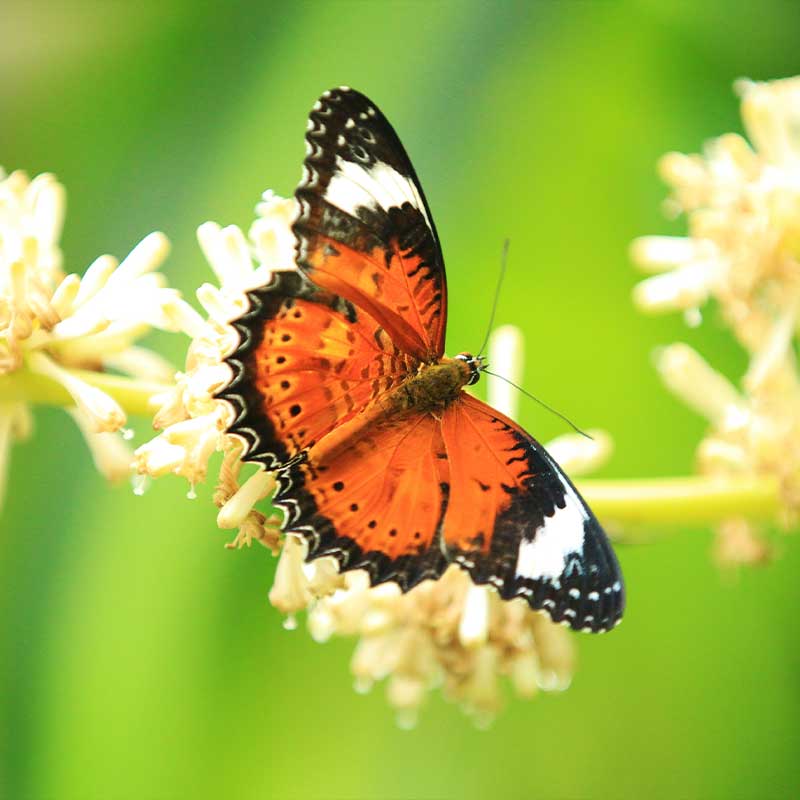
Cethosia penthesilea
Orange Lacewing butterflies are native to the far north of Australia.
Did you know?
– This is a very tough and active species which can be quite aggressive in defending its territory from other butterflies.
– The wingspan can measure approximately 7cm.
– The food plant for the caterpillars is Adenia heterophylla.
– The males and females have the same markings but the male has brighter orange colouring.
– These butterflies only live between 7 to 10 days.
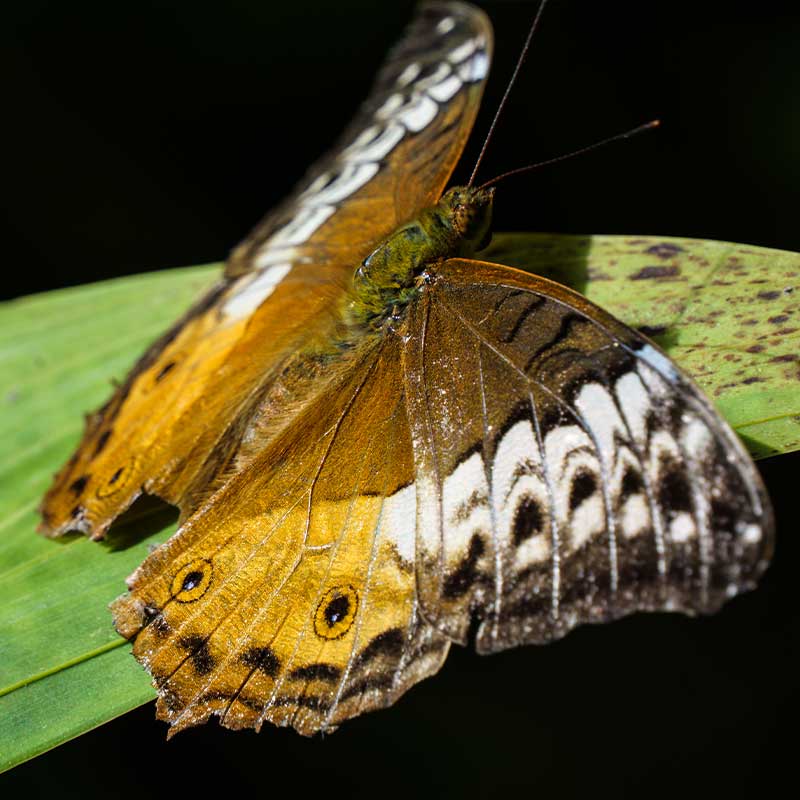
Vindula arsine
Cruiser Butterflies are native to Australia and found from the tip of Cape York to Townsville, Mackay and Yeppoon.
Did you know?
– Males and females are sexually dimorphic (they look different from each other).
– The females are reasonably big and quite beautiful, they lay their eggs in clusters on the tendrils of certain types of wild passionfruit vines.
– The food plants for the caterpillar are Adenia heterophylla, Hollrungia aurantioides and Passiflora aurantia.
– They have a wingspan of 8cm.
– These butterflies can live up to 4 weeks.

Yoma Sabina
Australian Lurcher Butterflies are found in the Northern parts of Australia.
Did you know?
– These butterflies display warning colours, but are not toxic – they mimic poisonous butterflies.
– The food plant for the caterpillar is Hemigraphis sp.
– This butterfly lives usually up to 9 weeks, but some specimens can live for up to nine months.
– Their longevity and endurance is aided by the fact that this butterfly hibernates for much of its life.
– The wing span of the butterfly is approximately 7 cm.

Papilio aegeus
The Orchard Swallowtail butterfly is one of the larger species in the region and it can also be found along the east coast of Australia.
Did you know?
– This butterfly gets its name from the fact that the food plant of its caterpillar is citrus for example, lemon, orange and grapefruit – all of which are often grown in orchards.
– In the early stages, the caterpillars are brown, white and shiny and look like bird droppings, which provides an effective camouflage.
– The wingspan of the butterfly is up to 14 cm.
– Males and females are dimorphic which means they have different coloured wings.
– These butterflies can live between 3 to 4 weeks.
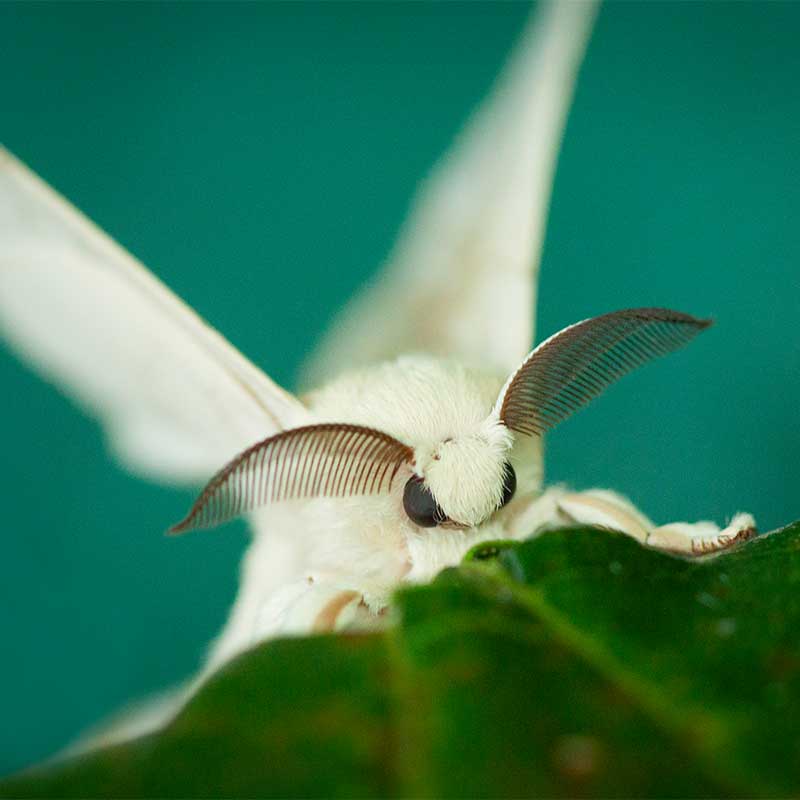
Bombyx mori
Silkmoths only live in captivity as they have been so domesticated that they have lost the ability to fly and therefore can no longer live in the wild.
Did you know?
– The host food plant for the caterpillar is the leaves of the Mulberry tree.
– Each cocoon is made of a single thread that measures approximately 914 metres long.
– Three thousand cocoons are required to produce 1kg of silk.
– Like the Hercules moths, silk moths cannot feed, so they only live long enough to mate and lay eggs – which is also only about 2 to 8 days.
– Our Silkmoth display is a seasonal display with the eggs hatching and caterpillars eating during the months of September to May. This is when the Mulberry leaves are growing well and provide abundant food for the caterpillars to eat.
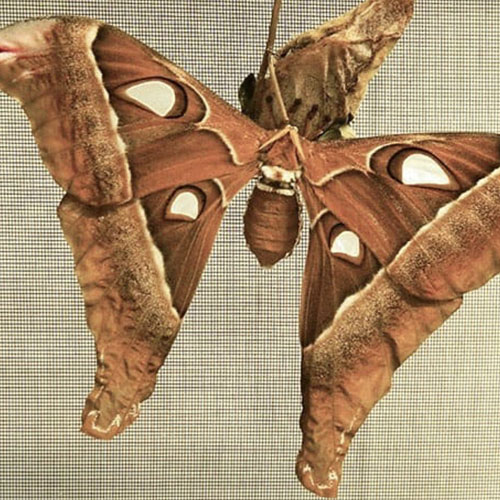
Coscinocera Hercules
The Hercules Moth is the world’s largest moth. It is only found in North Queensland and New Guinea.
Did you know?
– The largest Hercules moth ever recorded was a huge female caught in 1948 at Innisfail, just south of Cairns. The Guinness Book of Records states it had an incredible wingspan of 36cm (14.17 inches).
– The female Hercules moth is bigger than the male because it has to carry a belly full of eggs – up to 300 of them.
– The host food plant for the caterpillars is the Bleeding Heart tree (Omalthamus novoguineenis) and Cheese tree (Glochidion sp).
– The caterpillars get so large that they end up looking like green pork sausages with legs.
– They have been known to stay in their cocoons from two months to two years.
– The Hercules moths do not have a usable proboscis and cannot feed, so they only live long enough to find a mate and for the female to lay her eggs – which is about 2 to 8 days.
– Hercules moths are seasonal, however our breeding program is so successful that we always have Hercules cocoons, caterpillars or moths on display and sometimes all three at the same time, usually from September to June.

Danaus plexippus
This is the only non-native species bred here at the sanctuary, recorded sightings of the Monarch butterfly in Australia go back as far as the 1870s.
Did you know?
– This butterfly is Famous for its 3000km migration from Canada to Mexico.
– Their pupa has a green metallic sheen, and the caterpillars are boldly striped, black, white and yellow.
– They feed on the bitter, toxic sap of the milkweed plant which gives the caterpillars some defence against predators.

Hypolimnas alimena
A polymorphic butterfly species, the male and female are different colours – the male with striking blue bands on its wings, while the female is mostly brown to help her hide in the foliage.
Did you know?
– They occur right down the Queensland coastal regions to New South Wales.
– They live about 12 weeks as an adult butterfly.
– The caterpillar is dark brown and spiky.

Eurema hecabe
Found across a wide range of habitats, the grass yellow butterflies come in many variations and like the open grasslands and woodland.
Did you know?
– They are very gregarious and generally all emerge on the same day, so they have safety in numbers to survive predators.
– The males are typically a brighter yellow than the females, which may have darker markings on their wings.
– The wingspan of a Grass Yellow butterfly is about 1-2 inches.
– They have a lifespan of about 2-4 weeks.

Hypolimnas bolina
The Common Eggfly butterfly is commonly found in five states of Australia.
Did you know?
– They are also known as the “Varied Eggfly”.
– The male butterfly is extremely territorial and will chase all intruders out of their airspace.
– The female butterflies are unusual for butterflies – the individuals exhibit great variability in the colour and patterns found in their wings, so no two females are ever alike.
– The food plant for the caterpillars is Aystasia sp.
– These butterflies can live between 3 to 5 weeks.

Catopsilia scylla
Generally, these butterflies are more abundant during the wet season in March and April.
Did you know?
– They are migratory, feeding on various senna plants.
– The chrysalis is a bright lime green and becomes very wriggly when disturbed.
– The Orange Migrant has a wingspan of around 5-7 cm.
– The upper side of their wings is white with black markings, while the underside is bright yellow with a distinct rosy patch outlined in brown.
